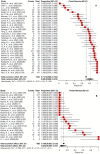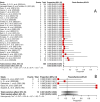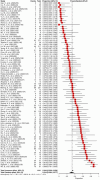Viral shedding of SARS-CoV-2 in body fluids associated with sexual activity: a systematic review and meta-analysis
- PMID: 38387982
- PMCID: PMC10882346
- DOI: 10.1136/bmjopen-2023-073084
Viral shedding of SARS-CoV-2 in body fluids associated with sexual activity: a systematic review and meta-analysis
Abstract
Objective: To identify and summarise the evidence on the severe acute respiratory syndrome coronavirus 2 (SARS-CoV-2) RNA detection and persistence in body fluids associated with sexual activity (saliva, semen, vaginal secretion, urine and faeces/rectal secretion).
Eligibility: All studies that reported detection of SARS-CoV-2 in saliva, semen, vaginal secretion, urine and faeces/rectal swabs.
Information sources: The WHO COVID-19 database from inception to 20 April 2022.
Risk of bias assessment: The National Institutes of Health tools.
Synthesis of results: The proportion of patients with positive results for SARS-CoV-2 and the proportion of patients with a viral duration/persistence of at least 14 days in each fluid was calculated using fixed or random effects models.
Included studies: A total of 182 studies with 10 023 participants.
Results: The combined proportion of individuals with detection of SARS-CoV-2 was 82.6% (95% CI: 68.8% to 91.0%) in saliva, 1.6% (95% CI: 0.9% to 2.6%) in semen, 2.7% (95% CI: 1.8% to 4.0%) in vaginal secretion, 3.8% (95% CI: 1.9% to 7.6%) in urine and 31.8% (95% CI: 26.4% to 37.7%) in faeces/rectal swabs. The maximum viral persistence for faeces/rectal secretions was 210 days, followed by semen 121 days, saliva 112 days, urine 77 days and vaginal secretions 13 days. Culturable SARS-CoV-2 was positive for saliva and faeces.
Limitations: Scarcity of longitudinal studies with follow-up until negative results.
Interpretation: SARS-CoV-2 RNA was detected in all fluids associated with sexual activity but was rare in semen and vaginal secretions. Ongoing droplet precautions and awareness of the potential risk of contact with faecal matter/rectal mucosa are needed.
Prospero registration number: CRD42020204741.
Keywords: COVID-19; INFECTIOUS DISEASES; Public health.
© Author(s) (or their employer(s)) 2024. Re-use permitted under CC BY-NC. No commercial re-use. See rights and permissions. Published by BMJ.
Conflict of interest statement
Competing interests: None declared.
Figures






References
-
- World Health Organization . Coronavirus disease (COVID-19) pandemic. n.d. Available: https://www.who.int/emergencies/diseases/novel-coronavirus-2019
Publication types
MeSH terms
Substances
Grants and funding
LinkOut - more resources
Full Text Sources
Medical
Research Materials
Miscellaneous
